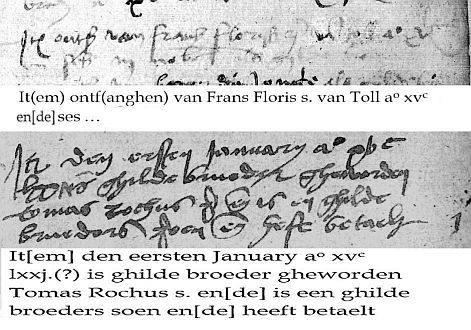


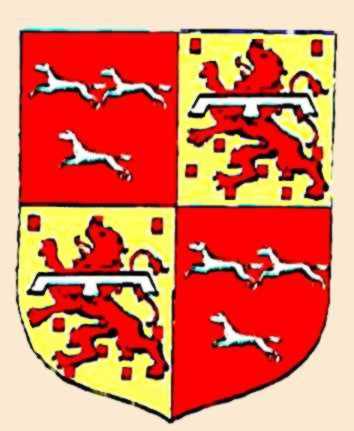
van Wesel van
den Honert
portal Van den Honert
my mother MSE van den Honert and all her ancestors
Van Wesel genealogy
Tussen Lek en Zuiderzee (Amerongse tak Van den Honert)
Thomas van den Honert (Voorburg/Leidschendam)
Van Tol (Toll, Tholl)
coat of arms
general index
Genealogy
Van Wesel and Van den Honert in Dordrecht:
Matthijs Balen,
Beschrijvinge der stad Dordrecht, 1677
Van den Honert in Ned. Patriciaat 31, 1945
According to Matthijs Balen the family's origin was German Wesel, but the famiily established itself in Brabant; Thomas Cleyszoon van Wesel came from Brabant to Dordrecht, Balen says, and married Christina van Slingelandt there.
His grandson Thomas Rochusz. and some of his brothers and sisters called themselves after a piece of land he
had acquired "Van den Hon(a)ert". The first time this name appears is on June 18th, 1561, when our ancestor Pieter is called Pieter Rochusz Honaart, see below, .
Maybe this "Honaert" was the place outside Dordrecht
where his great-grandson Herman, burgomaster of
Dordrecht, had a farm and some land
(see below).
But there was a place not so far from Dordrecht called den Honaert
(link); it seems this was an old dike SE of Strijen. Maybe the family owned a piece of land here. There was a Weeda family whose members also called themselves Van den Honaart after buying some land and establishing themselves there about 1590. It is interesting they used the same alternatives Honaert and Honert.
In Wateringen near The Hague there was a Hoonaerts tiend. As there were other well known families from Dordrecht owing houses here, also this can well have been the place Thomas van Wesel acquired.
There are more places called Honaert. My theory is it comes from Hogen Aert, High Earth.
When in 1786 my ancestor Joan van den Honert was
born, he was the only one to continue this name, so
now every Van den Honert is descended from him. There are
members in England, Canada, the U.S. and South Africa.
With the death in 1934 of Sara Anna Jacoba van Wesel, married to Willem Hartelust, the name would have disappeared, if their descendants wouldn't have continued the name, see
Hartelust family and
Van Wesel family
Of course many women had married men from families still
surviving: e.g. through Cornelia van Wesel and her
children from three husbands Van Noortwyck, Lupardus
and Schenck many people in the U.S. have Van Wesel
ancestors.
In the 17th century many rich and important families tried to
trace their origins back to ancient noble families. So the Van
Wesel family found an old "Van Wesele"
family near Antwerp, and declared themselves descended from that
family. What they didn't realize was, that Wesele, of which these
"ancestors" were the lords, was not German Wesel, but
the old name for 's-Gravenwezel near Antwerp.
After the northern Netherlands freed themselves from the Habsburg
king of Spain, one had to go abroad to get some noble title.
Rochus van den Honert
(link)
got the title of knight
from the Queen of Sweden for his diplomatic successes.
His great-grandson Johan or Jan van den
Honert was a member of the Raad van Brabant en Overmaze,
governing the parts of Brabant which were now part of our
country; Austrian Habsburg king Charles VI, governing the
southern parts (now Belgium) made "his friend" a
baronet, recognizing his pretentions to belong to the southern
Van Wesele family, and Johan acquired the barony of Piétrais les
Harlut, Rèves et Ruart near Nivelles/Nijvel, now Belgium.
Unfortunately all his children died.
Nothing has really been proven of these pretentions, and I don't
believe them to be true.
There is only one thing pointing to Antwerp: the mother of Thomas
Cleyszoon who came to Dordrecht is said to have been Machteld
van Berchem, daughter of Costijn van Berchem (called
Machteld van Verge by Balen, but that name doesn't exist).
Well, this Costijn has really lived, we know names of his
children, but nothing is known about a daughter called Machteld.
It is not impossible, though, this name is correct, and Thomas
and Cleys may certainly have lived somewhere in Brabant. All
members of the family in Dordrecht married people from
distinguished families, so Cleys may have married a Van Berchem.
But maybe it was made up to make the Wesele connexion more
probable.
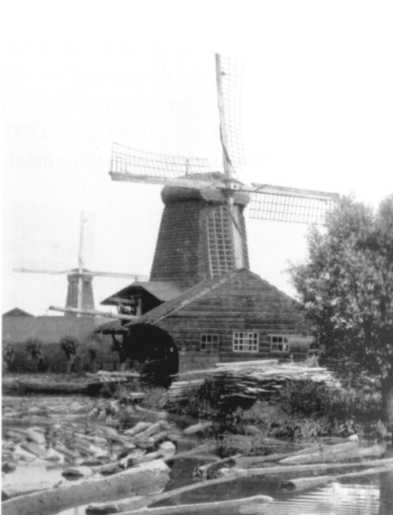
timber in Dordrecht, and behind "De Windhond",
one of the sawmills founded by the Van Wesel family
But all the same, in the Dordrecht archives I have found out many exciting facts about the family.
We knew already they had many functions in the town government,
but I have found out more.
Rochus Thomaszoon van Wesel is mentioned as a timber
trader, he married the daughter of a timber trader (Frans
Floriszoon van Tol, accepted into the Saint Nicholas guild
in 1506), his grandson and my ancestor Dirk Pieterszoon
van den Honert had the same profession, and so had his
son Frans Rochuszoon van Wesel (also called van
den Honert and van Tol).
His descendants played an important part in the timber trade and
industry. The family owned a number of sawmills, one of them
significantly called the "Van Wesele molen". It is also
from this branch Cornelia van Wesel came, who
went to New York.
Many marriages took place with members of other timber families
like De Witt (see De Witt), van Haarlem, Rees and De Vries.
These families were among the most important in Dordrecht,
economical and political power being in the same hands.
The independant Republic of the Netherlands started in Dordrecht
(end 16th century). The whole leadership became protestant in
1572. This town had been booming and was anxious to defend its
economic position. All the coins of Holland (the most important
province of the Netherlands) were struck here and they had the
monopoly for selling timber, which was transported from France
and especially from Germany, over the river Rhine, with enormous
rafts.
As the next town on the Rhine with this monopoly was Wesel,
there is a good chance the family came from there after all.
My ancestor Joan van den Honert (Dordrecht 1636-Norden 1721) worked as an engineer and cartographer in Northern Germany, where he called himself
Johann von Honart;
see his biography in Biographisches Lexikon für Ostfriesland.
He married a Frisian woman there and since then the Frisian names Taco Hajo are common in the family, the best known being their son the theology professor, and in our time the Dutch hockey player.
Later on we find back the family in The Hague and other
places. They were of course well educated and we find
relationships with well known cultural figures and scholars.
Knight Rochus van den Honert
(link)
wrote Latin poetry,
he and Mr. Herman van den Honert were curators
of Leyden University.
Dominicus van Wesel married Anna Roemers
Visscher, member of the "Muider Kring".

Handwriting of prof. Taco Hajo van den Honert, testifying that L.S. Grommé is attending his lectures:
"Ludovicum Suggeraat Gromme (= Grommé) viri venerandi Mauritii Gromme
Ecclesiæ Haganæ Pastoris fidelissimi filium mea frequentare collegia
testor. Lugd. Batav.
A.D. xxi. Mart. MDCCXX
T.H. van den Honert S.S. Th. (Sanctissimæ Theologiæ) Dr. et Profess.
"
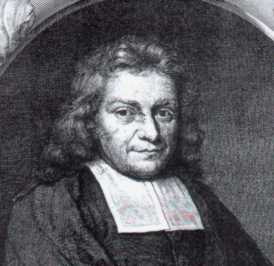
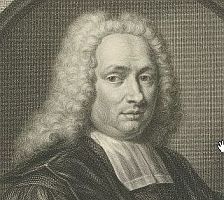
My ancestors Taco Hajo van den Honert and his son Jo(h)an van den Honert were fulltime scholars. They were both theology professors and had much authority in the official Reformed Church.
Professor Joan's grandson Joan van
den Honert born 1786, was a law specialist best known for his Formulierenboek.
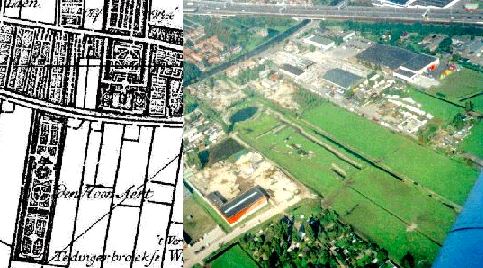

link
Thomas van den Honert (1606-1672), son of Knight Rochus, wagenmeester-generaal of the United Netherlands, Lord of Puttershoek (1670-1672),
acquired in 1648 an estate near Voorburg/The Hague which he called Den Honaert (written as Den Hoon Aert on this old map) like the piece of land his family name came from.
Opposite the canal is Hofwijck, built by politician and poet Constantijn Huygens. The families knew eachother well, read the article on my site about Thomas.
The photo was taken some years ago when excavations took place there. Look at the beautiful pond.
The old house has disappeared and a farm was built near the Westvlietweg, but the inhabitants of this beautiful house have called it Hofstede van den Honert.

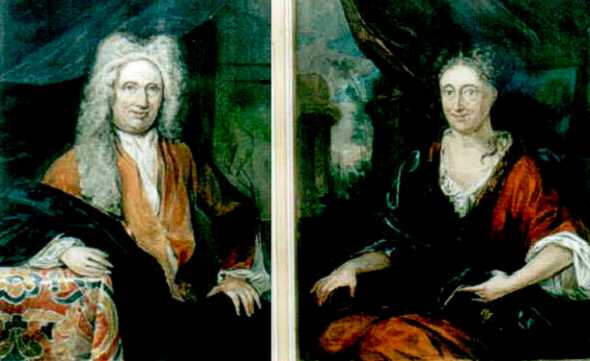
Herman van den Honert married Anna de Witt, daughter of Johan de Witt, raadpensionaris of Holland (see also De Witt)
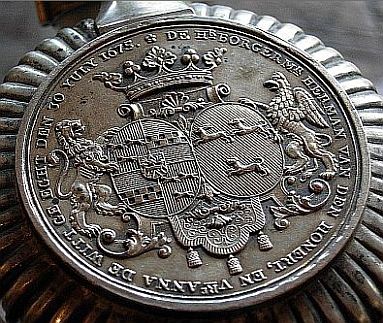
Mr. Herman van den Honert (1645-1730) was secretary (1674-88) and burgomaster of Dordrecht (1702, 1706-07, 1712-13, 1718-19 etc.). Many times he represented Dordrecht in the Gecommitteerde Raden van Holland. Since 1703 he was curator of Leyden University.
Lately I found back his "buitenhuis" near Dordrecht,
where he could retire from his busy life in town:
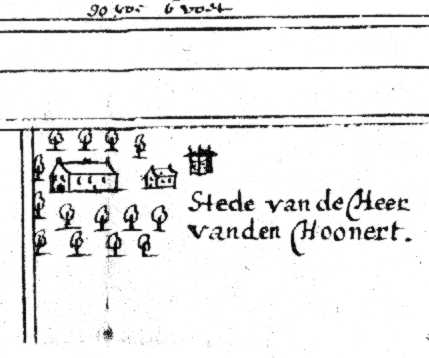
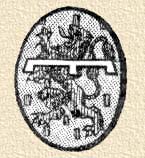
Rochus Thomaszoon van Wesel married Maryken van Tol. She was the daughter of Frans Florisz van Tol, whose name I found in the register of the Saint Nicholas Guild of which he became a member ("gildebroeder") in 1506. He had a number of functions in Dordrecht and was 'burgemeester van 's heeren wegen' in 1529-30 and 1540-42 (about this function).
The family pretended to be descended from the Van Teijlingen family and through them from the Counts of Holland. It is possible but much remains uncertain.
My mother's coat of arms is the one shown above, see more beautiful
here. It is a combination of Van Wesel and Van Tol. The Van Tol coat of arms shows the colors (gules on gold) and the lion of the County of Holland.
According to Balen:
Jonge Floris Florisz van Tol ∞ Machtild Vink
↓
Frederik Florisz van Tol ∞ Elisabeth van Boshuijsen
↓
• Simon Frederiksz van Tol ∞ Geertruijd Coppier van Calslagen
and
• Pieter Frederiksz van Tol ∞ Diewer van Alkemase
↓
Maurijn Pietersz van Tol ∞ Maria van Alphen
↓
Floris Maurijnsz van Tol, Balen doesn't know about a marriage!
↓
■ Floris Florisz van Tol, burgom. 1505-09 in Dordrecht, ∞ Maria Speyart
● Adriaen, raad en veertig 1558-62 in Dordrecht.
■ Frans Florisz van Tol, burgom. 1529-42, ∞ Catharina Bezemer
● Adriaen
● Maryken ∞ Rochus Thomasz van Wesel
But Balen made several mistakes.
Floris Florisz van Tol jr. never married a Machtild Vink, and never had a son Frederik.
First he married Clementia van Poelgeest, they had a daughter Elisabeth or Lysbeth who married Simon-Frederik Gerardsz.
A second marriage was to Heilwijf van Swieten Dirksdr, their son Dirk became the new Lord of Tol.
But when Dirk died without heir, he was succeeded by his sister's husband Simon-Frederik Gerardsz, who then could call himself van Tol.
He died in 1466 and his son Gerard Simon-Frederiksz van Tol took over, who had married Stefanie van Oudeveen Jacobsdr.
But in 1471 he handed over Huis Tol to his uncle Jacob Copppier Hendriksz and for a century the manor belonged to that family.
I assume he had a son Floris Gerardsz and they were our ancestors, because
I find this in the 'Repertorium op de grafelijke lenen in de grote Zuidhollandse Waard, 1276-1650' by J.C. Kort (link) about a 'schroodsambacht' (distributing wine and beer) in Dordrecht:
